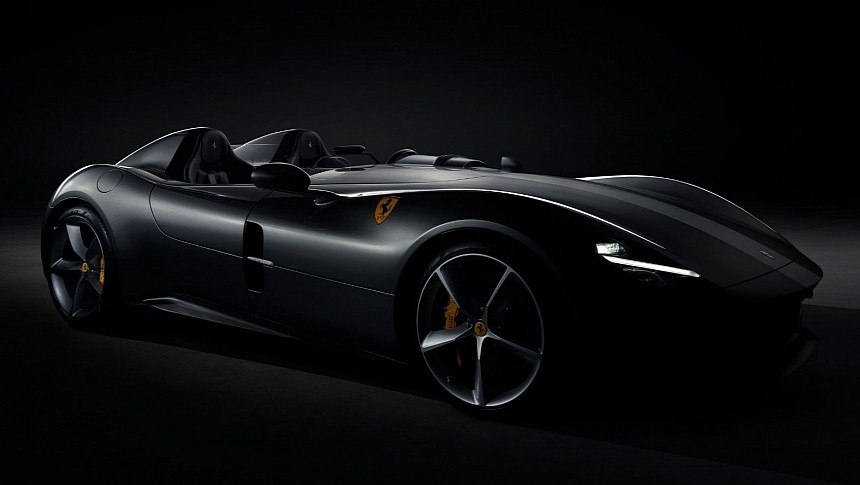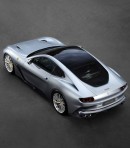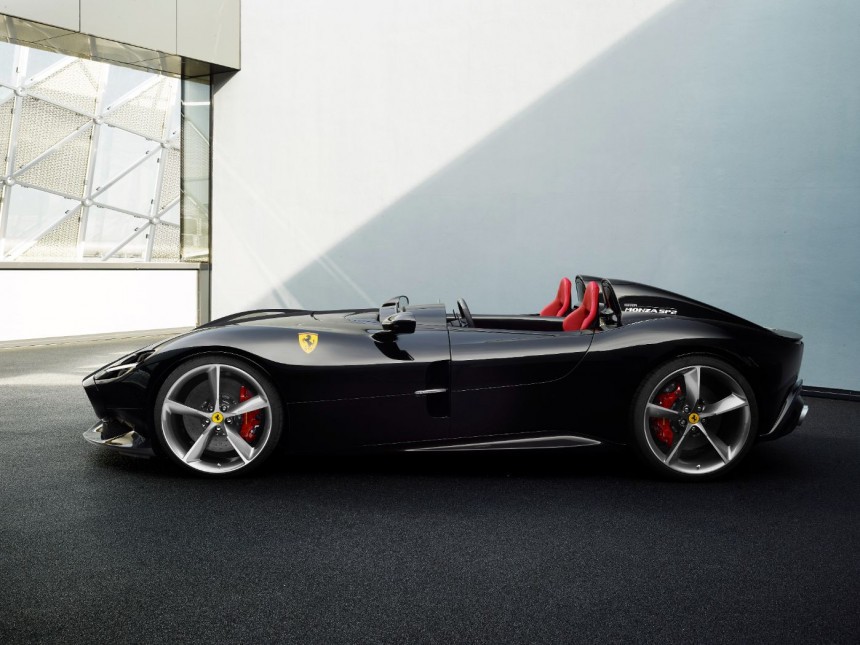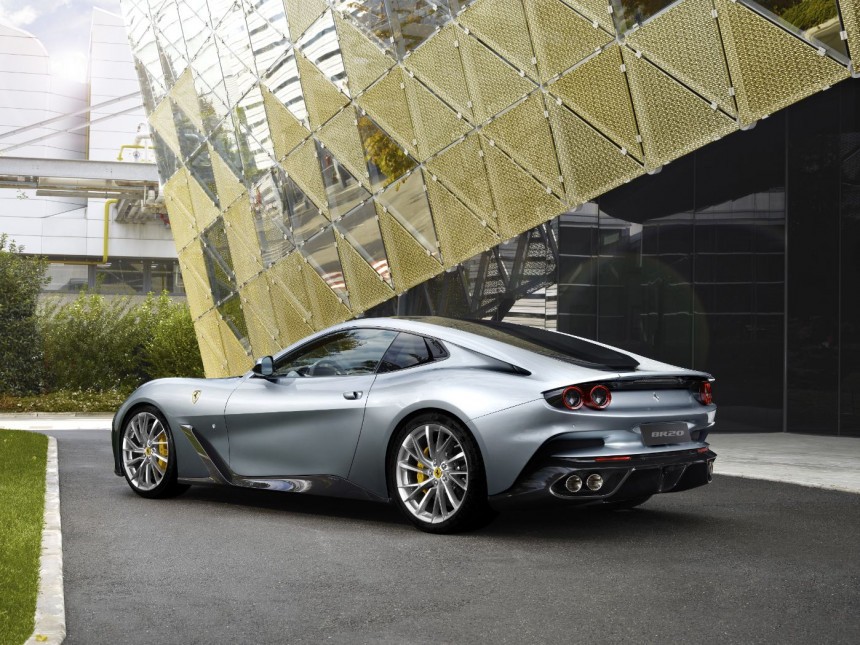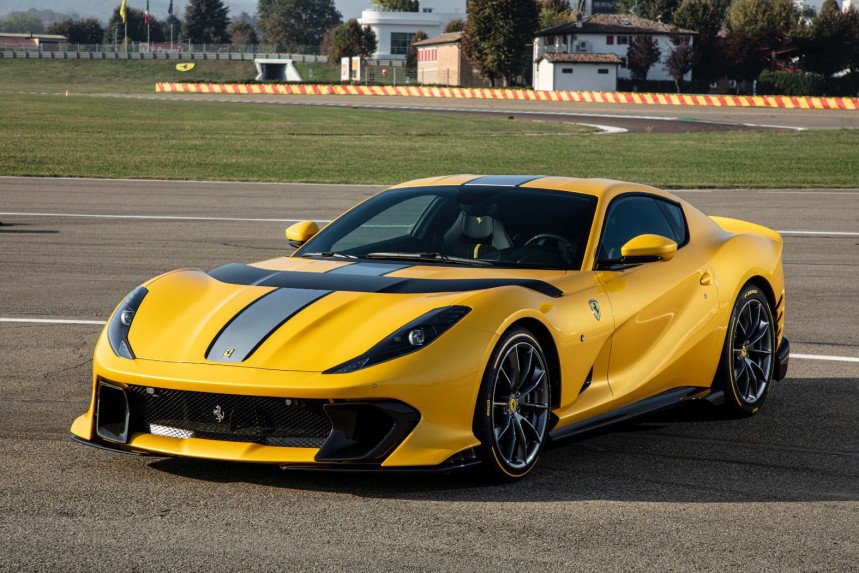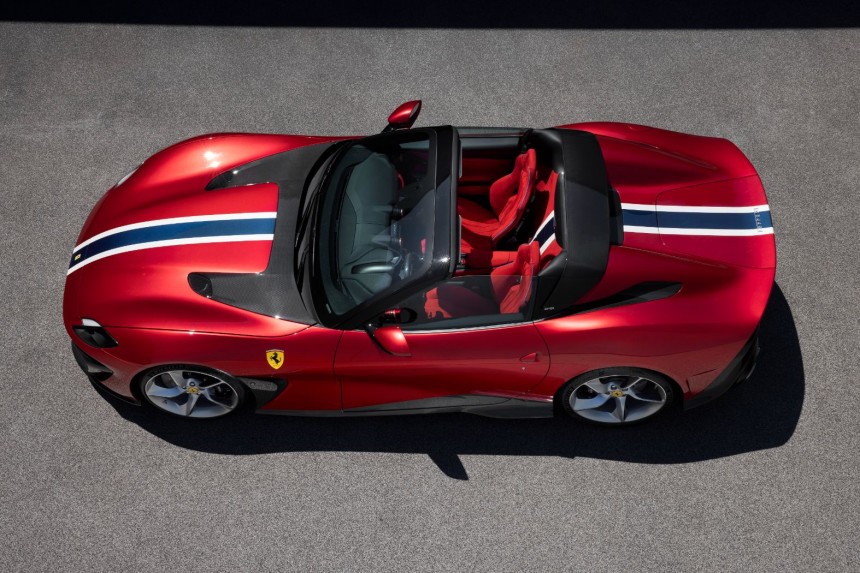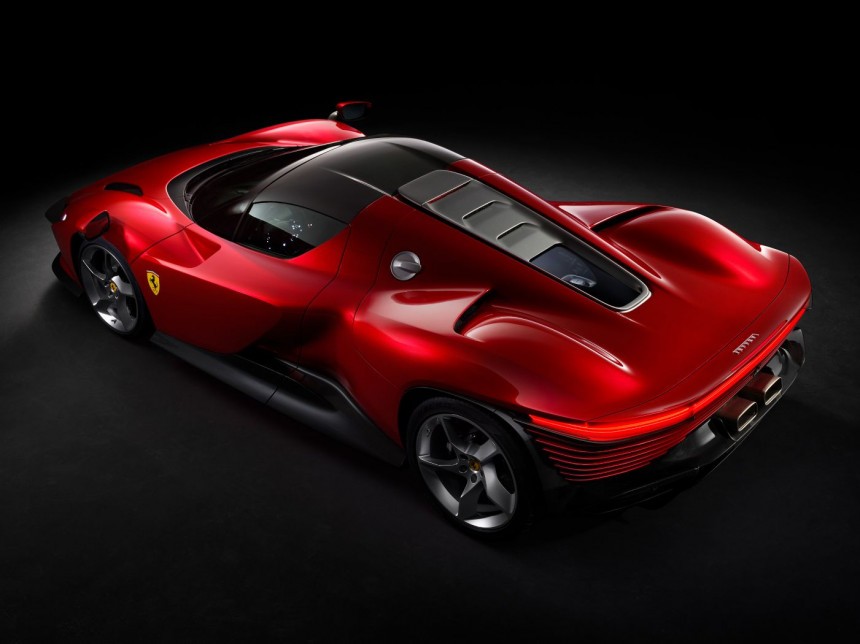Not long ago, there was an era when nearly every Ferrari proudly sported a magnificent V12 engine at the front, especially when looking back in history from a statistical point of view.
The few that deviated from this norm were primarily reserved for the racetrack, racing in events that didn't allow a twelve-cylinder or didn't quite merit the prestigious Cavallino Rampante emblem, like the V6-powered Dino.
Today, the landscape has significantly shifted, particularly as we're nearing the end of an era for Ferraris propelled by twelve-cylinder engines altogether.
As a matter of fact, only two cars from the modern lineup still feature a mighty V12 up front, not including various one-offs or limited-edition versions. Adding insult to injury, neither of the two is the top-of-the-range Ferrari, and one is an SUV (sort of).
Modern technology has enabled supercars, even Ferraris, to achieve incredible performance numbers using fewer or even no cylinders. Still, Maranello will likely remain synonymous with the mechanical symphony brought by V12 engines for the foreseeable future.
Interestingly, the first vehicle to bear the Ferrari name boasted a V12 engine with a capacity smaller than some modern hatchbacks, making it a candidate for fewer cylinders, in theory. However, the 125S from 1947 initiated a powertrain tradition that even Enzo Ferrari himself, to some extent, enforced.
Arriving into the world toward the close of the 19th century, Enzo Anselmo Giuseppe Maria Ferrari was raised during the embryonic period of the automobile. In that age, sheer power, not aerodynamic efficiency, dictated the speed of a car. This early exposure profoundly influenced his constant adherence to these ideals over the following decades. Enzo Ferrari epitomized old-school cool throughout his tenure at the helm of the eponymous company, earning him revered titles like 'il Commendatore' or 'il Grande Vecchio.'
His autocratic management style elevated him to the status of a larger-than-life figure. At one point, strong beliefs like "Aerodynamics are for people who can't build engines" and "The client is not always right" were engraved in his approach to the road car business.
Indeed, while it's true that some exceptional, high-end, classic, and even contemporary Ferraris sported different engine configurations and fewer cylinders over the years, the ones that genuinely embody Enzo's fundamental ideals pay homage to the mighty V12, revered as the epitome of his engineering vision.
Despite the final model he signed off, the F40, having a midship, twin-turbo V8, the man himself always said that a perfect Ferrari needs to have a long hood and a big, naturally aspirated V12 up front.
Considering this, I've curated a selection of modern Ferraris that would likely have been among Il Commendatore's favorites had he lived well beyond 120 years.
First up, we have the elegantly impractical Monza SP2. It's a slightly more practical iteration of the Monza SP1, mainly due to adding a passenger seat next to the driver's.
The Monza SP1 and SP2 mark the inception of Ferrari's Icona Series within the modern lineup. For those unfamiliar with the Icona Series, it's a unique program aimed at crafting limited-edition vehicles that draw inspiration from the timeless classics that define Ferrari's heritage.
Drawing design inspiration from legendary speedsters like the 750 Monza, 250 Testa Rossa, and the 166 MM, the Ferrari Monza SP2 is a modern mechanical marvel with a price tag just above the $1.5 million mark.
While its price might seem steep compared to more mainstream supercars, even from Maranello, it's essential to understand that the Ferrari Monza SP2 isn't your run-of-the-mill Ferrari. Limited to just 499 units, its exclusivity and exceptional design warrant its elevated cost.
Beneath the humongous clamshell hood lies a naturally aspirated 6.5-liter V12 engine that unleashes 799 horsepower at a stratospheric 8,500 rpm. This power catapults the Monza SP2 and its counterpart, the SP1, into the same territory as the most potent factory V12 Ferrari road cars ever built until its introduction.
The aerodynamic profile of the SP2 showcases a low-slung, carbon fiber speedster bodywork adorned with a pair of miniature scissor doors. A traditional windshield or conventional weather-repelling features for its two passengers are absent.
Instead, this supercar ingeniously employs a patented system by Ferrari known as the "Virtual Windshield." This innovative mechanism is supposed to redirect airflow away over the passengers, especially when cruising at higher speeds. However, Ferrari doesn't say if it can also redirect the flying bugs you will likely encounter during a road trip.
Ferrari's Special Projects Program (SPP) has gained notoriety for crafting exceptionally exclusive models tailored for well-off clients, and among these distinctive creations stands the remarkable BR20.
Using a GTC4 Lusso as the base, the SPP skunkworks team embarked on a journey to create the unique BR20, drawing inspiration from other gorgeous Ferrari grand tourers of the past, including the revered 410 Superamerica and the illustrious 500 Superfast. The outcome is a bespoke masterpiece that mixes heritage elements with modernity.
In other words, this is a unique, coach-built Ferrari specially crafted for a valued, long-standing customer of the Maranello automaker. That means that the price tag for this bespoke beauty remains undisclosed, but you can bet it went for at least seven figures.
Although technically rooted in the GTC4Lusso, the Ferrari BR20 showcases an entirely different aesthetic. The original shooting brake form has metamorphosed into a sleek fastback coupe, bidding farewell to the rear seats in the process.
Like in the olden days of coachbuilding, Ferrari's Special Projects division has adorned the BR20 with brand-new bodywork. The ensemble includes updated bumpers, exhaust tips, a rear diffuser, and headlights, forming a complete package of modifications. Additionally, the unique creation boasts a revamped interior adorned with two nuanced shades of brown leather upholstery, elegantly interwoven carbon fiber elements, and even some oak trim accents.
Remaining mechanically unaltered when compared to its donor vehicle, the Ferrari BR20 continues to depend on a naturally aspirated, 6.3-liter V12 powerplant. The engine churns out an impressive 681 HP (690 PS) at 8,000 rpm, ensuring the model can push effortlessly beyond the 200 miles per hour (322 kph) mark.
Derived from a prestigious lineage of front-engined, rear-wheel-driven V12 Ferraris, the 812 Competizione epitomizes what could be considered a perfect modern Ferrari through the lens of Enzo Ferrari's autocratic vision. Beneath its retro-inspired and meticulously sculpted exterior lies the mechanical essence of a Ferrari 812 Superfast, with every little component of its engine, suspension, and brakes pushed to the absolute limit.
The 6.5-liter block of the screaming V12 is identical to the one found in the donor car. However, the internal components have undergone meticulous refinement and distillation to dial its performance up to 11. The modified internals include redesigned pistons, lighter titanium con-rods, lighter by a striking 40 percent, and the integration of a new carbon coating over the piston pins, all contributing to the heightened performance capabilities of the 812 Competizione.
The crank has also been rebalanced and lightened, and to top it all off, there are new cylinder heads and a redesigned intake manifold. All these not only make the 812 Superfast... super faster... but were prerequisites to fully transform it into the 812 Competizione, a limited production, track-focused beast of a front-engined Ferrari.
Drawing inspiration from legendary models like the 250 GTO, the exterior design of the 812 Competizione looks almost traditional. However, beneath this classic façade lies a wealth of advanced features substantiating its vintage look. High-tech components such as active aero elements and rear-wheel-steering work in harmony to manage no less than 819 HP (830 PS), all of which are elegantly channeled to the rear wheels.
As another unique creation, the Ferrari SP51 was tailored for a prominent Ferrari collector from Taiwan. Renowned for a rather impressive Ferrari collection, the client sought an exceptional vehicle from Maranello. Using the technical architecture of the 812 GTS as a base, Ferrari's Styling Center embarked on a journey to transform the exterior design into a one-off masterpiece. The designers and engineers ensured that each detail was customized, akin to the 812 Competizione's enhancement over the 812 Superfast.
In other words, the Ferrari SP51 represents yet another unique, coach-built marvel. It's a one-off creation that underwent the same kind of development as a production car, including wind tunnel testing, to ensure it's visually stunning but can also walk the talk on both the road and track.
When pitted against the 812 GTS donor model, the SP51 showcases distinct modifications, sporting fresh headlights, custom wheels, and an entirely redesigned body. Notably, the double buttresses behind the occupants hark back to the racing cars of the 1950s, drawing inspiration from models like the 1955 Ferrari 410 S.
The vehicle is adorned in 'Rosso Passionale' three-layer paint, accentuating the brand's racing pedigree with a striking blue and white stripe that elegantly runs over the bodywork. This theme extends into the interior as well.
The 6.3-liter naturally aspirated V12 engine remains identical to the one found on the 812 GTS, giving its fortunate owner a whopping 789 HP (800 PS) to play with. When you've got that much power at your disposal, it's wise to hold onto your headgear when driving with the Targa top down.
Only 599 units of the Daytona SP3 will ever grace the roads, making it an even more exclusive gem than your average Ferrari. The exclusivity comes at a premium, with each example commanding a price of at least $2.25 million.This is also the only mid-engine model on our list, a departure from the usual front-midship configuration.
Regarding its exterior design, the model draws heavy inspiration from the legendary Ferrari 330 P3/P4 endurance race car, the famous winner of the 24 Hours of Daytona in 1967. However, despite its overall appearance, it isn't stuck in the past - the Daytona SP3 incorporates plenty of futuristic elements that give it the appearance of a machine born from the imagination of a science fiction author.
The Daytona SP3's overall shape brilliantly captures the essence of '60s sports prototypes, paying homage to an era that has influenced countless designers and engineers at Ferrari. Joining the likes of the Monza SP2 and SP1, the Daytona SP3 is a prominent member of the Icona Series. Notably, it holds the distinction of being Ferrari's most aerodynamically efficient production car ever, achieved without the utilization of active aero devices.
As expected, the 6.5-liter engine, now positioned in the car's midsection, behind the passengers, stands as the most powerful V12 ever fitted in a Ferrari road car. It unleashes no less than 830 HP (840 PS), and it can scream like a banshee at up to 9,500 rpm if you step on the go-fast pedal all the way,
Further emphasizing the exceptional nature of the Daytona SP3, all 599 units were swiftly snapped up through exclusive invitations even before the manufacturing commenced. On top of it, adding to desirability, every one of the 499 Monza SP1 and SP2 owners has also secured a Daytona SP3, leaving just a select 100 units for discerning private collectors.
No matter what the future will bring, the V12 will remain the quintessential Ferrari powertrain configuration. Renowned for their symphonic mechanical roar, they deliver an auditory experience that stirs the soul of any supercar aficionado. Enzo revered the V12 not just for its raw power but for its meticulous engineering and the emotional connection it evoked with the driver.
Enzo Ferrari's passion for V12-powered cars shaped the very essence of the Ferrari brand. This legacy remains alive and well long after his passing but will soon go the way of the dodo. Modern incarnations, such as the Ferrari 812 Competizione and the bespoke creations through the Special Projects Program, will probably be the final models to pay homage to Enzo's vision, infusing cutting-edge technology with the soul of a roaring twelve-cylinder.
Today, the landscape has significantly shifted, particularly as we're nearing the end of an era for Ferraris propelled by twelve-cylinder engines altogether.
As a matter of fact, only two cars from the modern lineup still feature a mighty V12 up front, not including various one-offs or limited-edition versions. Adding insult to injury, neither of the two is the top-of-the-range Ferrari, and one is an SUV (sort of).
Modern technology has enabled supercars, even Ferraris, to achieve incredible performance numbers using fewer or even no cylinders. Still, Maranello will likely remain synonymous with the mechanical symphony brought by V12 engines for the foreseeable future.
Interestingly, the first vehicle to bear the Ferrari name boasted a V12 engine with a capacity smaller than some modern hatchbacks, making it a candidate for fewer cylinders, in theory. However, the 125S from 1947 initiated a powertrain tradition that even Enzo Ferrari himself, to some extent, enforced.
Arriving into the world toward the close of the 19th century, Enzo Anselmo Giuseppe Maria Ferrari was raised during the embryonic period of the automobile. In that age, sheer power, not aerodynamic efficiency, dictated the speed of a car. This early exposure profoundly influenced his constant adherence to these ideals over the following decades. Enzo Ferrari epitomized old-school cool throughout his tenure at the helm of the eponymous company, earning him revered titles like 'il Commendatore' or 'il Grande Vecchio.'
His autocratic management style elevated him to the status of a larger-than-life figure. At one point, strong beliefs like "Aerodynamics are for people who can't build engines" and "The client is not always right" were engraved in his approach to the road car business.
Indeed, while it's true that some exceptional, high-end, classic, and even contemporary Ferraris sported different engine configurations and fewer cylinders over the years, the ones that genuinely embody Enzo's fundamental ideals pay homage to the mighty V12, revered as the epitome of his engineering vision.
Despite the final model he signed off, the F40, having a midship, twin-turbo V8, the man himself always said that a perfect Ferrari needs to have a long hood and a big, naturally aspirated V12 up front.
Considering this, I've curated a selection of modern Ferraris that would likely have been among Il Commendatore's favorites had he lived well beyond 120 years.
Ferrari Monza SP2
The Monza SP1 and SP2 mark the inception of Ferrari's Icona Series within the modern lineup. For those unfamiliar with the Icona Series, it's a unique program aimed at crafting limited-edition vehicles that draw inspiration from the timeless classics that define Ferrari's heritage.
Drawing design inspiration from legendary speedsters like the 750 Monza, 250 Testa Rossa, and the 166 MM, the Ferrari Monza SP2 is a modern mechanical marvel with a price tag just above the $1.5 million mark.
While its price might seem steep compared to more mainstream supercars, even from Maranello, it's essential to understand that the Ferrari Monza SP2 isn't your run-of-the-mill Ferrari. Limited to just 499 units, its exclusivity and exceptional design warrant its elevated cost.
Beneath the humongous clamshell hood lies a naturally aspirated 6.5-liter V12 engine that unleashes 799 horsepower at a stratospheric 8,500 rpm. This power catapults the Monza SP2 and its counterpart, the SP1, into the same territory as the most potent factory V12 Ferrari road cars ever built until its introduction.
The aerodynamic profile of the SP2 showcases a low-slung, carbon fiber speedster bodywork adorned with a pair of miniature scissor doors. A traditional windshield or conventional weather-repelling features for its two passengers are absent.
Instead, this supercar ingeniously employs a patented system by Ferrari known as the "Virtual Windshield." This innovative mechanism is supposed to redirect airflow away over the passengers, especially when cruising at higher speeds. However, Ferrari doesn't say if it can also redirect the flying bugs you will likely encounter during a road trip.
Ferrari BR20
Using a GTC4 Lusso as the base, the SPP skunkworks team embarked on a journey to create the unique BR20, drawing inspiration from other gorgeous Ferrari grand tourers of the past, including the revered 410 Superamerica and the illustrious 500 Superfast. The outcome is a bespoke masterpiece that mixes heritage elements with modernity.
In other words, this is a unique, coach-built Ferrari specially crafted for a valued, long-standing customer of the Maranello automaker. That means that the price tag for this bespoke beauty remains undisclosed, but you can bet it went for at least seven figures.
Although technically rooted in the GTC4Lusso, the Ferrari BR20 showcases an entirely different aesthetic. The original shooting brake form has metamorphosed into a sleek fastback coupe, bidding farewell to the rear seats in the process.
Like in the olden days of coachbuilding, Ferrari's Special Projects division has adorned the BR20 with brand-new bodywork. The ensemble includes updated bumpers, exhaust tips, a rear diffuser, and headlights, forming a complete package of modifications. Additionally, the unique creation boasts a revamped interior adorned with two nuanced shades of brown leather upholstery, elegantly interwoven carbon fiber elements, and even some oak trim accents.
Remaining mechanically unaltered when compared to its donor vehicle, the Ferrari BR20 continues to depend on a naturally aspirated, 6.3-liter V12 powerplant. The engine churns out an impressive 681 HP (690 PS) at 8,000 rpm, ensuring the model can push effortlessly beyond the 200 miles per hour (322 kph) mark.
Ferrari 812 Competizione
The 6.5-liter block of the screaming V12 is identical to the one found in the donor car. However, the internal components have undergone meticulous refinement and distillation to dial its performance up to 11. The modified internals include redesigned pistons, lighter titanium con-rods, lighter by a striking 40 percent, and the integration of a new carbon coating over the piston pins, all contributing to the heightened performance capabilities of the 812 Competizione.
The crank has also been rebalanced and lightened, and to top it all off, there are new cylinder heads and a redesigned intake manifold. All these not only make the 812 Superfast... super faster... but were prerequisites to fully transform it into the 812 Competizione, a limited production, track-focused beast of a front-engined Ferrari.
Drawing inspiration from legendary models like the 250 GTO, the exterior design of the 812 Competizione looks almost traditional. However, beneath this classic façade lies a wealth of advanced features substantiating its vintage look. High-tech components such as active aero elements and rear-wheel-steering work in harmony to manage no less than 819 HP (830 PS), all of which are elegantly channeled to the rear wheels.
Ferrari SP51
In other words, the Ferrari SP51 represents yet another unique, coach-built marvel. It's a one-off creation that underwent the same kind of development as a production car, including wind tunnel testing, to ensure it's visually stunning but can also walk the talk on both the road and track.
When pitted against the 812 GTS donor model, the SP51 showcases distinct modifications, sporting fresh headlights, custom wheels, and an entirely redesigned body. Notably, the double buttresses behind the occupants hark back to the racing cars of the 1950s, drawing inspiration from models like the 1955 Ferrari 410 S.
The vehicle is adorned in 'Rosso Passionale' three-layer paint, accentuating the brand's racing pedigree with a striking blue and white stripe that elegantly runs over the bodywork. This theme extends into the interior as well.
The 6.3-liter naturally aspirated V12 engine remains identical to the one found on the 812 GTS, giving its fortunate owner a whopping 789 HP (800 PS) to play with. When you've got that much power at your disposal, it's wise to hold onto your headgear when driving with the Targa top down.
Ferrari Daytona SP3
Regarding its exterior design, the model draws heavy inspiration from the legendary Ferrari 330 P3/P4 endurance race car, the famous winner of the 24 Hours of Daytona in 1967. However, despite its overall appearance, it isn't stuck in the past - the Daytona SP3 incorporates plenty of futuristic elements that give it the appearance of a machine born from the imagination of a science fiction author.
The Daytona SP3's overall shape brilliantly captures the essence of '60s sports prototypes, paying homage to an era that has influenced countless designers and engineers at Ferrari. Joining the likes of the Monza SP2 and SP1, the Daytona SP3 is a prominent member of the Icona Series. Notably, it holds the distinction of being Ferrari's most aerodynamically efficient production car ever, achieved without the utilization of active aero devices.
As expected, the 6.5-liter engine, now positioned in the car's midsection, behind the passengers, stands as the most powerful V12 ever fitted in a Ferrari road car. It unleashes no less than 830 HP (840 PS), and it can scream like a banshee at up to 9,500 rpm if you step on the go-fast pedal all the way,
Further emphasizing the exceptional nature of the Daytona SP3, all 599 units were swiftly snapped up through exclusive invitations even before the manufacturing commenced. On top of it, adding to desirability, every one of the 499 Monza SP1 and SP2 owners has also secured a Daytona SP3, leaving just a select 100 units for discerning private collectors.
The Legacy Lives On
Speculating Enzo Ferrari's precise thoughts on these modern V12 Ferraris will remain a mystery, considering his profound focus on racing rather than crafting art on wheels for collectors. Yet, imagining that he wouldn't have been awestruck by the sight and sound of these five near-perfect Ferraris is a stretch; indeed, anyone with an appreciation for exceptional engineering would undoubtedly be captivated.No matter what the future will bring, the V12 will remain the quintessential Ferrari powertrain configuration. Renowned for their symphonic mechanical roar, they deliver an auditory experience that stirs the soul of any supercar aficionado. Enzo revered the V12 not just for its raw power but for its meticulous engineering and the emotional connection it evoked with the driver.
Enzo Ferrari's passion for V12-powered cars shaped the very essence of the Ferrari brand. This legacy remains alive and well long after his passing but will soon go the way of the dodo. Modern incarnations, such as the Ferrari 812 Competizione and the bespoke creations through the Special Projects Program, will probably be the final models to pay homage to Enzo's vision, infusing cutting-edge technology with the soul of a roaring twelve-cylinder.
